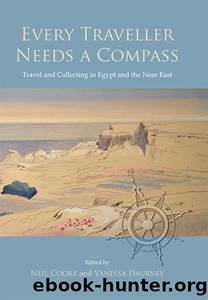Every Traveller Needs a Compass by Cooke Neil;Daubney Vanessa;Daubney Vanessa;

Author:Cooke, Neil;Daubney, Vanessa;Daubney, Vanessa;
Language: eng
Format: epub
Tags: HISTORY / Ancient / Egypt
ISBN: 4392699
Publisher: Oxbow Books, Limited
Published: 2015-10-31T00:00:00+00:00
UNWILLING TRAVELLERS
During the 16th and 17th centuries, Istanbul was famous as a major slave market. Among the slaves traded in the city were many Slavs and Russians. The most famous of these was Roksolana (or Hurem), who had been enslaved somewhere in the Western Ukraine and then sold to the hereditary prince, the future Sultan Mehmed II. Although personal data of most of these people has been lost forever, there were some who recorded their stories.
Among the last of the Muscovite travellers to Egypt in pre-imperial times, is one unwilling traveller who was brought to the Ottoman Empire in captivity. Soon after his return, his notes, which he had secretly written over many years and had managed to keep hidden, were published under the title Description of the Turkish Empire.
While the name of this unfortunate man and his background are not known, judging from the published text, he is likely to have been a well-trained military officer. There are also some grounds for assuming that he may have been a young aristocrat named Feodor Dorohin, who was captured by Crimean Tartars and who spent 12 years away from home between 1662 and 1674.
According to the author of the Description, he walked all over the Empire, excluding a few minor provinces. Since he travelled a great deal, he was hardly a man who shared the common destiny of so many Russian slaves in the Ottoman Empire during the 17th century. In fact, there is a strong reason to suppose that he moved through the country accompanying a Turkish army. And if so, he may have changed his faith and become a Muslim. The indifference shown to the principal âcultâ attractions of the Holy Land that he visited during the course of his wanderings perhaps backs up this assumption.
The Description demonstrates that during his stay in the Ottoman Empire, the Russian officer must have learned Turkish and Arabic, or at the least have been able to understand what was being said. However, he was also at something of a disadvantage when his work is compared with the numerous books written by western European travellers of that time who were often well educated, if not scholars, and who provided in their texts extensive historical and cultural information. On the other hand, the narrow-mindedness of the Russian captive, who concentrated his descriptions almost exclusively on military aspects, should not overshadow the fact that he was one of the few Europeans who walked around the country, at times visiting areas far from the traditional routes of foreign travellers.
In Egypt, the prisoner visited Cairo (Egupt), Bulak, Damietta, Rashid (Rosetta), Aboukir and Alexandria. His Description does not mention any ancient monuments, but it gives a good idea of the geographical position of Egyptian cities as well as the heights of Cairoâs fortifications. He also noted his scepticism of the ability of the local Arabs to withstand an army equipped with firearms. Yet he admitted the quality of Cairoâs defence system and noted the strategic importance of Saladinâs fort.
Download
This site does not store any files on its server. We only index and link to content provided by other sites. Please contact the content providers to delete copyright contents if any and email us, we'll remove relevant links or contents immediately.
1610396766 (N) by Jo Ann Jenkins(1298)
Whatever You Do, Don't Run by Peter Allison(1246)
Botswana--Culture Smart! by Michael Main(1238)
In Arabian Nights by Tahir Shah(1199)
Livingstone by Tim Jeal(1152)
The Old Farmer's Almanac 2020 by Old Farmer’s Almanac(1152)
Ubuntu by Ellis Heather;(1136)
The Templars by Michael Haag(1125)
Dead Eye by Mark Greaney(1106)
Africa: Altered States, Ordinary Miracles by Richard Dowden(1078)
Top 10 Israel and Petra by DK Travel(1070)
Morocco Travel Guide by Lonely Planet(1065)
Egypt Travel Guide by Lonely Planet(1055)
The Promise of a Pencil: How an Ordinary Person Can Create Extraordinary Change by Braun Adam(1055)
False Papers by André Aciman(1050)
First Comes Love, then Comes Malaria by Eve Brown-Waite(1042)
Jeff Corwin by Jeff Corwin(1030)
The Masked Rider by Neil Peart(987)
African Nights by Kuki Gallmann(966)
